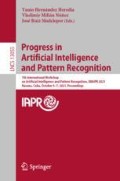Abstract
In this paper, three Glottal Opening Instants Detectors are simultaneously evaluated with three glottal measures and two concepts of pulse boundaries. Performance has to be evaluated in the absence of reference locations. The evaluation is made over a subset of 120 pathological voice samples. Results show that, among detectors, the crossing over the 3/7 of the pulses’ amplitude span performs better. Considering ratios of pulse phases’ duration, results support the modeling of the effect of jitter in the glottal pulse as a constant warping between glottal closure instants.
Access this chapter
Tax calculation will be finalised at checkout
Purchases are for personal use only
References
Fant, G.: Acoustic Theory of Speech Production. Mouton, The Hage (1960)
Veldhuis, R.: A computationally efficient alternative for the Liljencrants-Fant model and its perceptual evaluation. J. Acoust. Soc. Am. 103, 566–571 (1998). https://doi.org/10.1121/1.421103
Ferrer, C., Hernández-Díaz, M.E., González, E.: Using waveform matching techniques in the measurement of shimmer in voiced signals. In: Interspeech 2007: 8th Annual Conference of the International Speech Communication Association, pp. 2436–2439 (2007)
Hanquinet, J., Grenez, F., Schoentgen, J.: Synthesis of disordered voices. In: Faundez-Zanuy, M., Janer, L., Esposito, A., Satue-Villar, A., Roure, J., Espinosa-Duro, V. (eds.) NOLISP 2005. LNCS (LNAI), vol. 3817, pp. 231–241. Springer, Heidelberg (2006). https://doi.org/10.1007/11613107_20
Drugman, T., Alku, P., Alwan, A., Yegnanarayana, B.: Glottal source processing: from analysis to applications. Comput. Speech Lang. 28, 1117–1138 (2014). https://doi.org/10.1016/j.csl.2014.03.003
Rosenberg, A.E.: Effect of glottal pulse shape on the quality of natural vowels. J. Acoust. Soc. Am. 49, 583–590 (1971). https://doi.org/10.1121/1.1973515
Kreiman, J., et al.: Variability in the relationships among voice quality, harmonic amplitudes, open quotient, and glottal area waveform shape in sustained phonation. J. Acoust. Soc. Am. 132, 2625–2632 (2012). https://doi.org/10.1121/1.4747007
Lieberman, P.: Some acoustic measures of the fundamental periodicity of normal and pathologic larynges. J. Acoust. Soc. Am. 35, 344–353 (1963). https://doi.org/10.1121/1.1918465
Titze, I.R.: Workshop on Acoustic Voice Analysis: Summary Statement. NCVS. 36 (1994). https://doi.org/10.1016/S0892-1997(97)80022-7.
Boersma, P.: Should jitter be measured by peak picking or by waveform matching? Folia Phoniatr. Logop. 61, 305–308 (2009). https://doi.org/10.1159/000245159
Horii, Y.: Some statistical characteristics of voice fundamental frequency. J. Speech Hear. Res. 18, 192–201 (1975)
Roark, R.M.: Frequency and voice: perspectives in the time domain. J. Voice. 20, 325–354 (2006). https://doi.org/10.1016/j.jvoice.2005.12.009
Ferrer, C.A., Torres, D., González, E., Calvo, J.R., Castillo, E.: Effect of different jitter-induced glottal pulse shape changes in periodicity perturbation measures. In: Proceedings of the Annual Conference of the International Speech Communication Association, INTERSPEECH (2015)
Degottex, G., Kane, J., Drugman, T., Raitio, T., Scherer, S.: COVAREP – A Collaborative Voice Analysis Repository for Speech technologies. In: IEEE International Conference on Acoustics, Speech and Signal Processing, pp. 960–964 (2014)
Childers, D., Larar, J.N.: Electroglottography for laryngeal function assessment and speech analysis. IEEE Trans. Biomed. Eng. BME-31(12), 807–817 (1984). https://doi.org/10.1109/TBME.1984.325242
Abberton, E., Fourcin, A.: Electrolaryngography. In: Ball, M.J., Code, C. (eds.) Instrumental Clinical Phonetics, pp. 119–148. Whurr Publishers Ltd., London (1997)
Henrich, N., d’Alessandro, C., Doval, B., Castellengo, M.: On the use of the derivative of electroglottographic signals for characterization of nonpathological phonation. J. Acoust. Soc. Am. 115, 1321–1332 (2004). https://doi.org/10.1121/1.1646401
Baken, R.J.: Electroglottography. J. Voice. 6, 98–110 (1992). https://doi.org/10.1097/00002508-199209000-00009
Krishnamurthy, A., Childers, D.: Two-channel speech analysis. IEEE Trans. Acoust. Speech Signal Process. 34(4), 730–743 (1986). https://doi.org/10.1109/TASSP.1986.1164909
Howard, D.M.: Variation of electrolaryngographically derived closed quotient for trained and untrained adult female singers. J. Voice. 9, 163–172 (1995)
Pützer, M., Barry, W.J.: Saarbruecken Voice Database. http://stimmdb.coli.uni-saarland.de/. Accessed 16 Mar 2018
Harar, P., Alonso-Hernandez, J.B., Mekyska, J., Galaz, Z., Burget, R., Smekal, Z.: Voice pathology detection using deep learning: a preliminary study. In: International Conference and Workshop on Bioinspired Intelligence, IWOBI 2017. pp. 1–4. IEEE Xplore, Madeira (2017)
Ferrer, C., Torres, D., Hernández-Díaz, M.E.: Using dynamic time warping of T0 contours in the evaluation of cycle-to-cycle Pitch Detection Algorithms. Pattern Recognit. Lett. 31, 517–522 (2010). https://doi.org/10.1016/j.patrec.2009.07.021
Acknowledgements
This work was partially supported by an Alexander von Humboldt Foundation Fellowship granted to one of the authors (Ref 3.2-1164728-CUB-GF-E).
Author information
Authors and Affiliations
Corresponding author
Editor information
Editors and Affiliations
Rights and permissions
Copyright information
© 2021 Springer Nature Switzerland AG
About this paper
Cite this paper
Riesgo, C.A.F., Rodríguez-Guillén, R., Nöth, E. (2021). Evaluation of GOI Detectors in EGG Signals Assuming Different Models for the Pulse Length Variability. In: Hernández Heredia, Y., Milián Núñez, V., Ruiz Shulcloper, J. (eds) Progress in Artificial Intelligence and Pattern Recognition. IWAIPR 2021. Lecture Notes in Computer Science(), vol 13055. Springer, Cham. https://doi.org/10.1007/978-3-030-89691-1_42
Download citation
DOI: https://doi.org/10.1007/978-3-030-89691-1_42
Published:
Publisher Name: Springer, Cham
Print ISBN: 978-3-030-89690-4
Online ISBN: 978-3-030-89691-1
eBook Packages: Computer ScienceComputer Science (R0)

